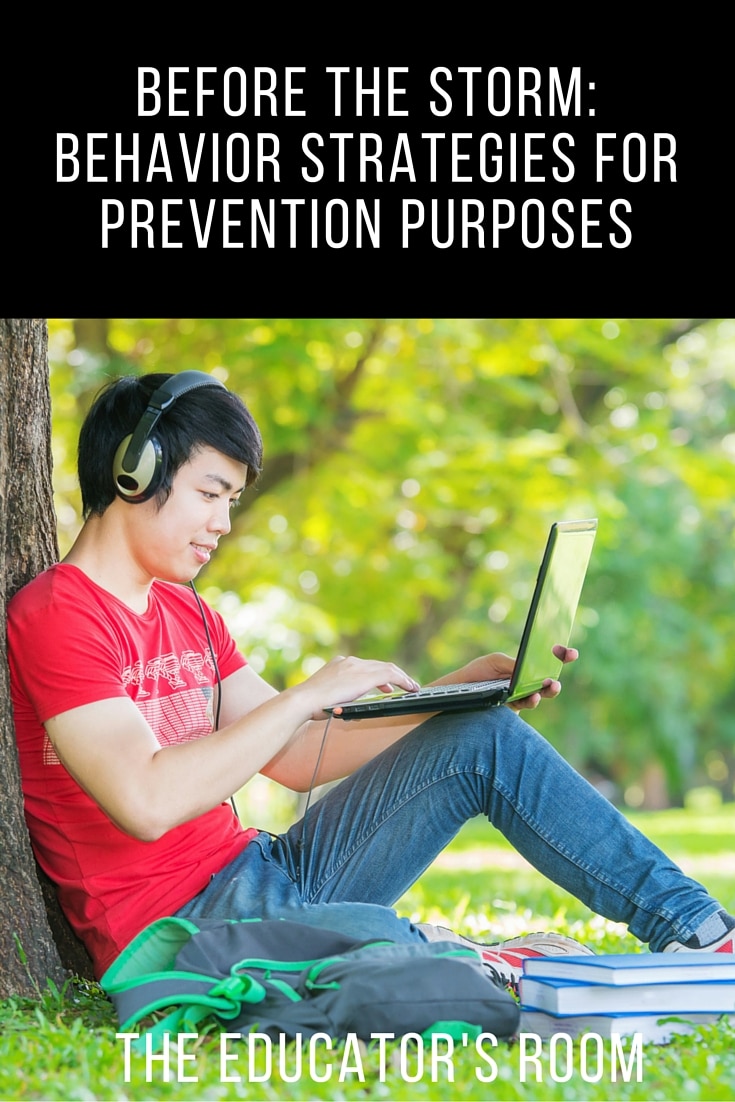Think of that kid in the room that just can’t seem to make it through the class period. Things just seem to set that student off for some reason, and you don’t know what to do. Up until now, you’ve probably used strategies for handling the behavior after it’s already happened. But before you batten down the hatches again, here are some behavior strategies to use before the storm.
- Offer choices whenever possible – That’s right. Give the student choices on things that you can handle giving them free reign over. Maybe it’s okay for him or her to decide who to work with, what book to read, or when to complete the assignment by (can you negotiate a due date?). Perhaps you can give a list of possible ways the students can complete an assignment (write a poem, a rap song, a story, etc.). Choices mean a lot to the student who wants to control everything.
- Break the tasks up into manageable pieces – Many students misbehave simply because they’re overwhelmed. They would rather misbehave than admit it’s too hard for them. What do they get when you send them to the office? Task avoidance. Try taking an assignment and breaking into manageable chunks and giving the student mini-breaks in between to do something fun or relaxing.
- Increase the reinforcement quality of the classroom – Does the student enjoy coming to class? What exists in the room to make the student want to come back? Add interesting classroom displays (posters, bulletin boards, etc.), increase the pace of the classroom discussion, increase student interaction, and add some activities to the classroom routine. Students like to move and a fast-paced class keeps students engaged in learning.
- Present help strategies – But don’t just present these options to that one student; teach the entire class how they can ask for help in a disciplined way. They can do things like post a help-signal (post-it notes work really well if you want to keep a stack at each table) and continue working or ask a peer-helper for support (make sure you discuss in advance how peer-helpers work in your classroom).
- Review the rules/expectations – Any time you see a challenging situation coming up or a change in routine, you should review the rules and expectations with the class. Don’t expect them to just remember your rules and follow them, because that’s when things usually go awry. Tell them what you expect when X-Y-Z happens and you’ll head off so many more issues. If you have a reward system, reminding the class now and then about the reward system and points system (if you have one) can help boost them again if they’ve started to slack off of the reward system.
- Rearrange the seating/set-up of the classroom – If your student is distracted or easily disturbed by the people round him or her, it’s probably time to change things up. Maybe the students needs to have a more private seating location, or maybe the student would work best with a mild-mannered student. Think about your options and do some really thoughtful planning of your seating.
- Instruction of Skills – It’s possible that the student lacks adequate skills to display appropriate behaviors in the classroom. In that case, you may need to set up a time to teach those skills to the student. During those times, you’ll want to provide some examples to show the student the skill-set being taught. Demonstration via modeling/role-playing works really well followed by a check-up via student demonstration or a verbal walk-through to show acquisition of skills.
- Teach How to Take a Calm-down Break – Many teachers carry out a calm-down break as an accommodation, but this is actually something that needs to be taught to the student before the student needing to take the break. If the student is regularly angry at his or her peers or set off by large groups of people, then it’s best to 1) teach the student how to identify when feelings of tension, excitement, and anger and 2) take a short break away from the situation until calm enough to return to class.
Keep in mind that these strategies are just strategies to use before the storm. They will not help if you’re in the middle of a thunderous situation. However, if you’re proactive and addressing the students’ needs before the storm, you’re much less likely to get in situations where you need to call fire-and-rescue to help you with a tornadic situation. Never fear, though, I do plan to address what to do during the storm in a future post.







Leave a comment